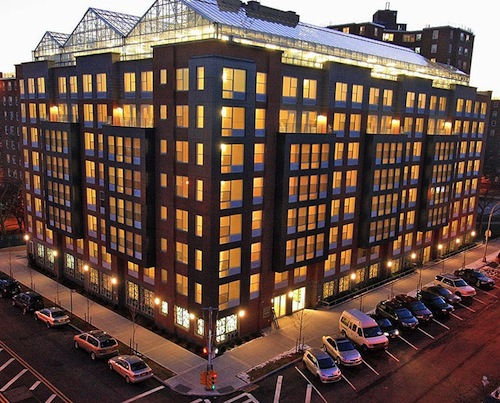The New York City Housing Authority has opened Arbor House, a 124-unit complex in the Morrisania neighborhood of the Bronx. The LEED Platinum building includes energy-efficient HVAC, a "green wall" lobby feature, and a 10,000-sf hydroponic farm on the roof.
Designed by ABS Architects, the $37.7 million facility is the result of a collaboration between the NYCHA, the NYC Department of Housing Preservation and Development, and Blue Sea Development. The public-private initiative was part of a city program to recruit private companies to develop dilapidated and vacant NYCHA land. About 2,000 units in the program are currently under construction or in pre-development in Manhattan, the Bronx and Brooklyn.
Arbor House, an eight-story building, contains 16 studios, 33 one-bedroom apartments, and 75 two-bedroom apartments, plus superintendent quarters. Residents must earn less than 60% of the area median income ($49,800 for a family of four). Residents will start moving in during the next few weeks. HPD spokesperson RuthAnne Visnauskas says the city is pushing for more sustainable design in its public housing facilities. The rooftop farm, a first for the agency, will be operated by third party Sky Vegetables and is expected to generate money by selling produce commercially, with some of the yield set aside for building residents and other local families.
About $37 million of the project cost was subsidized via local, state, and city subsidies, Reso A funds, tax credit equities, and tax-exempt bonds.
(http://observer.com/2013/02/an-arbor-in-the-forest-green-affordable-housing-development-opens-in-the-bronx/)
Related Stories
| Sep 29, 2011
CEU series examines environmental footprint and performance properties of wood, concrete, and steel
Each course qualifies for one AIA/CES HSW/SD Learning Unit or One GBCI CE Hour.
| Sep 29, 2011
Kohler supports 2011 Solar Decathlon competition teams
Modular Architecture > In a quest to create the ultimate ‘green’ house, 20 collegiate teams compete in Washington D.C. Mall.
| Sep 29, 2011
AIA Dallas names new executive director
AIA Dallas one of only a few chapters in the U.S. to be led by an accomplished architect.
| Sep 29, 2011
Potter honored with SMSP honor
The Society for Marketing Professional Services (SMPS) recognized Alfred K. Potter II, FSMPS, senior vice president with Gilbane Building Co., with the 2011 Weld Coxe Marketing Achievement Award (MAA).
| Sep 28, 2011
Look who's coming to BD+C's Under-40 Leadership Summit
AEC industry "under-40 superstars" from top design and construction firms have signed up for BD+C's "Under-40 Leadership Summit."
| Sep 28, 2011
GBCI announces LEED fellow class of 2011
LEED Fellows represent green building industry's most accomplished professionals.
| Sep 28, 2011
Bradley sponsors design studio on intelligent buildings for UWM SARUP
The studio is taught by Gregory D. Thomson, assistant professor and co-director of the Institute for Ecological Design at UWM.














